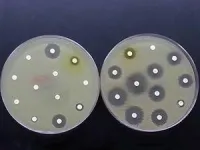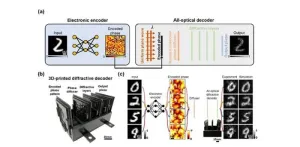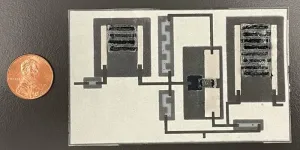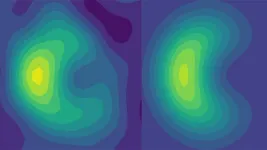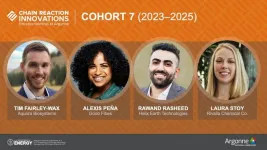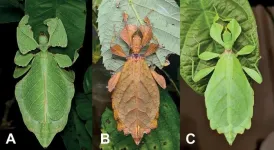(Press-News.org)
High-quality sequencing of nearly the entire kākāpō population, funded through a Genomics Aotearoa project, is helping New Zealand to manage the health of this critically endangered species.
Not only is it already making a difference to kākāpō survival, but establishing sequencing methods to work with populations under threat is also likely to be the foundation for the future of endangered wildlife science in New Zealand and the rest of the world.
The state-of-the-art methods developed by Dr. Joseph Guhlin (University of Otago ) and an international team to study kākāpō has revealed important aspects of kākāpō biology. The methods, reusable code, and pipeline is a blueprint and tool for conservation genomics in other species, especially intensively managed species. This has massive implications.
Dr. Guhlin’s work over the last year have two very significant outcomes:
an in-depth understanding of kākāpō biology that simply would not be possible without genomics
high-quality code and reusable pipeline – allowing other researchers to rapidly integrate these methods into their own work – which has significantly advanced New Zealand’s genomic capability.
This has given researchers the tools needed to identify specific genetic characteristics that are crucial to survival.
“Using technology created by Google, we have achieved what is likely the highest quality variant dataset for any endangered species in the world. This dataset is made available, through DOC and Ngai Tahu, for future researchers working with Kākāpō,” Dr Guhlin said.
Department of Conservation’s Science Advisor for Kākāpō Recovery, Dr. Andrew Digby, believes the genetic tools this study provides will make an immense difference to kākāpō conservation.
“Kākāpō suffer from disease and low reproductive output, so by understanding the genetic reasons for these problems, we can now help mitigate them. It gives us the ability to predict things like kākāpō chick growth and susceptibility to disease, which changes our on-the-ground management practices and will help improve survival rates.”
While the study marks the beginning of a new era of kākāpō conservation genetics, Dr Digby acknowledges what it means for the future of all threatened species.
“The Kakapo125+ project is a great example of how genetic data can assist population growth. The novel genetic and machine learning tools developed can be applied to improve the productivity and survival of other taonga under conservation management.”
The research results have been published in the prestigious international journal Nature Ecology and Evolution.
For more information, please contact Dr. Joseph Guhlin, Phone 027-867-2100, joseph.guhlin@otago.ac.nz and joseph.guhlin@gmail.com
About Genomics Aotearoa
Genomics Aotearoa is a collaborative platform of 10 research institutes and universities, established to ensure that New Zealand is internationally participating and leading in the rapidly developing fields of genomics (the study of the genome, the complete set of genetic material present in a cell or organism) and bioinformatics (the development of methods and software tools for understanding the biological data derived from genomics).
An important aspect of Genomics Aotearoa’s research approach is that developing and fine-tuning genomic processes in one species will potentially produce valuable roadmaps for analysing genetic diversity in others across humans, environment, and primary production. This is already starting to happen.
END
Saving species from extinction - high-quality kākāpō population sequencing provides breakthrough in understanding key conservation genetics
2023-08-29
ELSE PRESS RELEASES FROM THIS DATE:
High-fidelity transmission of information via novel electronic-optical system
2023-08-28
Transferring optical information in free space with large bandwidth and high transmission capacity has gained significant attention in various applications, such as remote sensing, underwater communication, and medical devices. Nevertheless, unpredictable, unknown phase perturbations or random diffusers within the optical path pose great challenges, limiting the high-fidelity transmission of optical data in free space. Adaptive optics presents a potential solution that can correct for random distortions ...
Two studies demonstrate the benefits and limitations of artificial intelligence in colonoscopy
2023-08-28
Embargoed for release until 5:00 p.m. ET on Monday 28 August 2023
Annals of Internal Medicine Tip Sheet
@Annalsofim
Below please find summaries of new articles that will be published in the next issue of Annals of Internal Medicine. The summaries are not intended to substitute for the full articles as a source of information. This information is under strict embargo and by taking it into possession, media representatives are committing to the terms of the embargo not only on their own behalf, but also on behalf of the ...
Professor receives grant to develop electronic devices made entirely of paper
2023-08-28
Imagine if you could build an electronic device made entirely of paper. A nontoxic, cost-effective and biodegradable alternative to silicon- and plastic-based components would be a game-changer for a planet quickly filling up with the “e-waste” of discarded gadgets and single-use sensors.
That’s the vision of Binghamton University Professor Seokheun (Sean) Choi. He’s worked for years creating better biobatteries that use bacteria or human sweat to generate energy. Some of those batteries have been paper-based, and now he hopes to apply that knowledge to ...
Quantum computer unveils atomic dynamics of light-sensitive molecules
2023-08-28
DURHAM, N.C. – Researchers at Duke University have implemented a quantum-based method to observe a quantum effect in the way light-absorbing molecules interact with incoming photons. Known as a conical intersection, the effect puts limitations on the paths molecules can take to change between different configurations.
The observation method makes use of a quantum simulator, developed from research in quantum computing, and addresses a long-standing, fundamental question in chemistry critical to processes such as photosynthesis, vision and photocatalysis. It is also an example of ...
Enter Sandman: Study shows dreams spill over into the workplace and can be channeled for productivity
2023-08-28
Before heading to work each day, most people have spent the night dreaming. Studies show that on any given morning, about 40 percent of the working population recalls their dreams.
New research from the University of Notre Dame shows that when dreams are first recalled, people often draw connections between their dreams and waking lives, and the connections they draw alter how they think, feel and act at work.
“A Spillover Model of Dreams and Work Behavior: How Dream Meaning Ascription Promotes Awe and Employee Resilience” is forthcoming in the Academy of Management Journal from lead author Casher Belinda, assistant professor ...
Gender disparities limit chances for women PhD students training to be new inventors
2023-08-28
In the innovation economy, individuals with STEM PhDs are a critical source of human capital, with nearly 60 percent of PhDs in STEM fields— such as engineering, chemistry and biology—being employed outside of universities. These students are increasingly contributing to commercial science through patenting. New research from MIT Sloan School of Management and Copenhagen Business School investigated the training of these PhD students to better understand the pipeline and preparation of new inventors.
Conducted by Fiona Murray, MIT Sloan professor and associate dean for Innovation and Inclusion, ...
New startups join Argonne’s entrepreneurship program
2023-08-28
Four new innovators recently joined Chain Reaction Innovations (CRI), the Lab-Embedded Entrepreneurship Program at the U.S. Department of Energy’s (DOE’s) Argonne National Laboratory, as part of the program’s seventh cohort.
Each innovator will collaborate with a host scientist at Argonne while embedded full-time at the laboratory. Innovators plan to develop clean energy startups that reduce greenhouse gas emissions and increase U.S. competitiveness in emerging energy technologies. The ...
Curious and cryptic: new leaf insects discovered
2023-08-28
An international research team including the University of Göttingen has described seven previously unknown species of leaf insects, also known as walking leaves. The insects belong to the stick and leaf insect order, which are known for their unusual appearance: they look confusingly similar to parts of plants such as twigs, bark or – in the case of leaf insects – leaves. This sophisticated camouflage provides excellent protection from predators as well as presenting a challenge to researchers. Genetic analysis enabled the researchers to discover “cryptic species”, which cannot be distinguished by their external appearance alone. The findings are not only ...
Preparing clinicians for the international anti-LGBTQI+ crisis
2023-08-28
Contact: Maria Ober, 617-224-8963, mpober@bu.edu
Preparing Clinicians for the International Anti-LGBTQI+ Crisis
Medical community should build systems that are responsive to this population
(Boston)—Lesbian, gay, bisexual, transgender, queer, intersex and additional sexual and gender minority (LGBTQI+) people in every region of the world face marginalization and oppression. At least 67 countries ban sexual conduct between consenting adults of the same sex. According to a report from the ...
PSA levels after treatment may not be reliable predictor of survival for patients with prostate cancer
2023-08-28
FINDINGS
A UCLA-led study found treatments that reduce the risk of being diagnosed with a cancer recurrence based on rising prostate-specific antigen (PSA) levels after radiotherapy, commonly referred to as biochemical recurrence, do not necessarily improve a patient’s long-term overall survival.
The team of investigators found that while biochemical recurrence was associated with a higher risk of death, it still did not meet the criteria to be a reliable surrogate endpoint for overall survival. As defined by the FDA, a clinical outcome directly measures whether people in a trial feel or function better, or live ...


